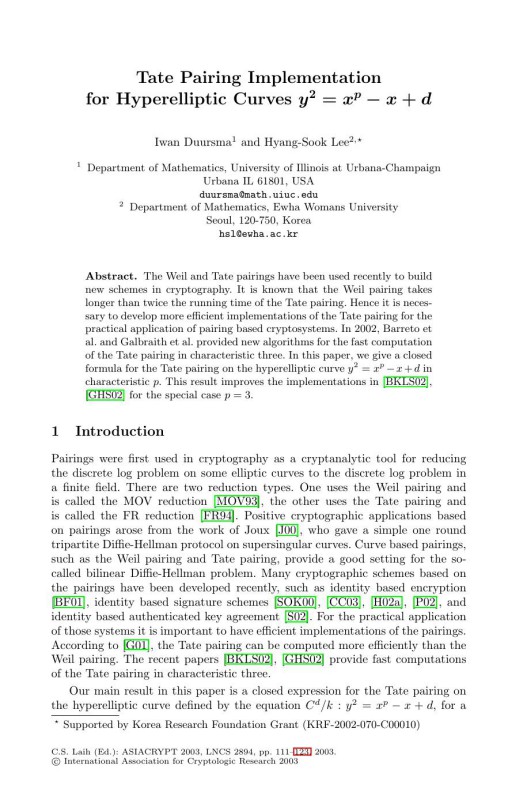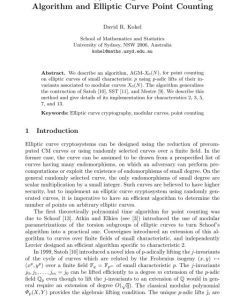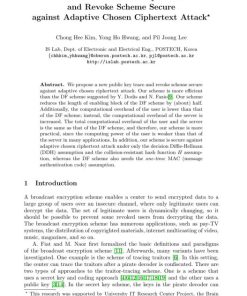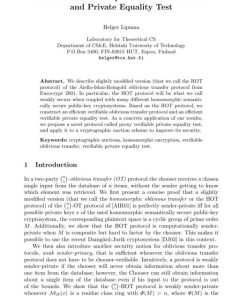Tate Pairing Implementation for Hyperelliptic y 2 = x p – x + d 1st edition by Iwan Duursma, Hyang Sook Lee ISBN 3540205920 9783540205920
$50.00 Original price was: $50.00.$25.00Current price is: $25.00.
Authors:Iwan Duursma; Hyang-Sook Lee , Tags:Advances in Cryptology – ASIACRYPT 2003 , Author sort:Duursma, Iwan & Lee, Hyang-Sook , Languages:Languages:eng , Published:Published:Oct 2003
Tate Pairing Implementation for Hyperelliptic y 2 = x p – x + d 1st edition by Iwan Duursma, Hyang-Sook Lee – Ebook PDF Instant Download/Delivery. 3540205920, 978-3540205920
Full download Tate Pairing Implementation for Hyperelliptic y 2 = x p – x + d 1st Edition after payment

Product details:
ISBN 10: 3540205920
ISBN 13: 978-3540205920
Author: Iwan Duursma, Hyang-Sook Lee
The Weil and Tate pairings have been used recently to build new schemes in cryptography. It is known that the Weil pairing takes longer than twice the running time of the Tate pairing. Hence it is necessary to develop more efficient implementations of the Tate pairing for the practical application of pairing based cryptosystems. In 2002, Barreto et al. and Galbraith et al. provided new algorithms for the fast computation of the Tate pairing in characteristic three. In this paper, we give a closed formula for the Tate pairing on the hyperelliptic curve y 2 = x p – x + d in characteristic p. This result improves the implementations in [BKLS02], [GHS02] for the special case p=3.
Tate Pairing Implementation for Hyperelliptic y 2 = x p – x + d 1st Table of contents:
-
Introduction
- 1.1 Overview of Hyperelliptic Curves
- 1.2 Introduction to the Tate Pairing
- 1.3 Relevance of the Curve y2=xp−x+dy^2 = x^p – x + dy2=xp−x+d
- 1.4 Contributions of the Paper
- 1.5 Organization of the Paper
-
Preliminaries
- 2.1 Mathematical Background of Hyperelliptic Curves
- 2.1.1 Definition and Properties of Hyperelliptic Curves
- 2.1.2 The Curve y2=xp−x+dy^2 = x^p – x + dy2=xp−x+d
- 2.2 Elliptic and Hyperelliptic Curve Cryptography
- 2.3 The Tate Pairing: Definition and Properties
- 2.3.1 Tate Pairing on Elliptic Curves
- 2.3.2 Generalization to Hyperelliptic Curves
- 2.4 Computational Complexity Considerations
- 2.1 Mathematical Background of Hyperelliptic Curves
-
Mathematical Formulation of the Curve y2=xp−x+dy^2 = x^p – x + dy2=xp−x+d
- 3.1 Curve Definition and Structure
- 3.2 Singularities and Smoothness of the Curve
- 3.3 Points on the Curve and Group Law
- 3.4 Special Properties of the Curve for Pairing-Based Cryptography
-
Tate Pairing on Hyperelliptic Curves
- 4.1 The Tate Pairing: Generalization to Hyperelliptic Curves
- 4.2 Pairing Computations in Characteristic ppp
- 4.3 Efficient Computation of the Tate Pairing on y2=xp−x+dy^2 = x^p – x + dy2=xp−x+d
- 4.3.1 Algorithmic Approach to Tate Pairing
- 4.3.2 Optimization Techniques for Efficient Pairing Computation
- 4.4 Pairing-Based Cryptography on Hyperelliptic Curves
-
Implementation of the Tate Pairing
- 5.1 Choice of Parameters for Implementation
- 5.2 Efficient Algorithms for Tate Pairing Computation
- 5.2.1 Miller’s Algorithm for Pairing Computation
- 5.2.2 Final Exponentiation and Optimization
- 5.3 Software Implementation Details
- 5.3.1 Choice of Cryptographic Libraries and Tools
- 5.3.2 Code Optimization for Performance
- 5.4 Hardware Implementation Considerations
- 5.4.1 Optimizing for FPGA and ASIC Architectures
- 5.4.2 Comparison with Elliptic Curve Pairings
-
Security Considerations
- 6.1 Security of the Tate Pairing on Hyperelliptic Curves
- 6.2 Attacks on Pairing-Based Cryptosystems
- 6.2.1 Move to Cryptographic Attacks: Miller’s Algorithm Vulnerabilities
- 6.2.2 Side-Channel Attacks and Countermeasures
- 6.3 Potential Application Areas and Security Implications
-
Performance Analysis
- 7.1 Computational Efficiency: Time and Space Complexity
- 7.2 Experimental Results on Pairing Computation
- 7.2.1 Benchmarks on Various Hardware Platforms
- 7.2.2 Comparison with Other Curve Families
- 7.3 Scalability of the Implementation
-
Applications of Tate Pairing on Hyperelliptic Curves
- 8.1 Pairing-Based Cryptosystems
- 8.2 Identity-Based Encryption Using the Tate Pairing
- 8.3 Applications in Zero-Knowledge Proofs and Digital Signatures
- 8.4 Post-Quantum Cryptography Considerations
-
Extensions and Future Work
- 9.1 Generalizing the Approach to Other Hyperelliptic Curves
- 9.2 Improvements in Pairing Efficiency and Security
- 9.3 Future Applications in Cryptography and Beyond
- 9.4 Open Problems and Challenges in Pairing Implementation
-
Conclusion
- 10.1 Summary of Contributions
- 10.2 Final Thoughts on Hyperelliptic Curve Pairings
- 10.3 Future Directions for Research and Implementation
People also search for Tate Pairing Implementation for Hyperelliptic y 2 = x p – x + d 1st:
tate reduced pairing
kagan mix-pair-share
quadratic pair share
qiime2 paired end tutorial
pairing state paired and secured












